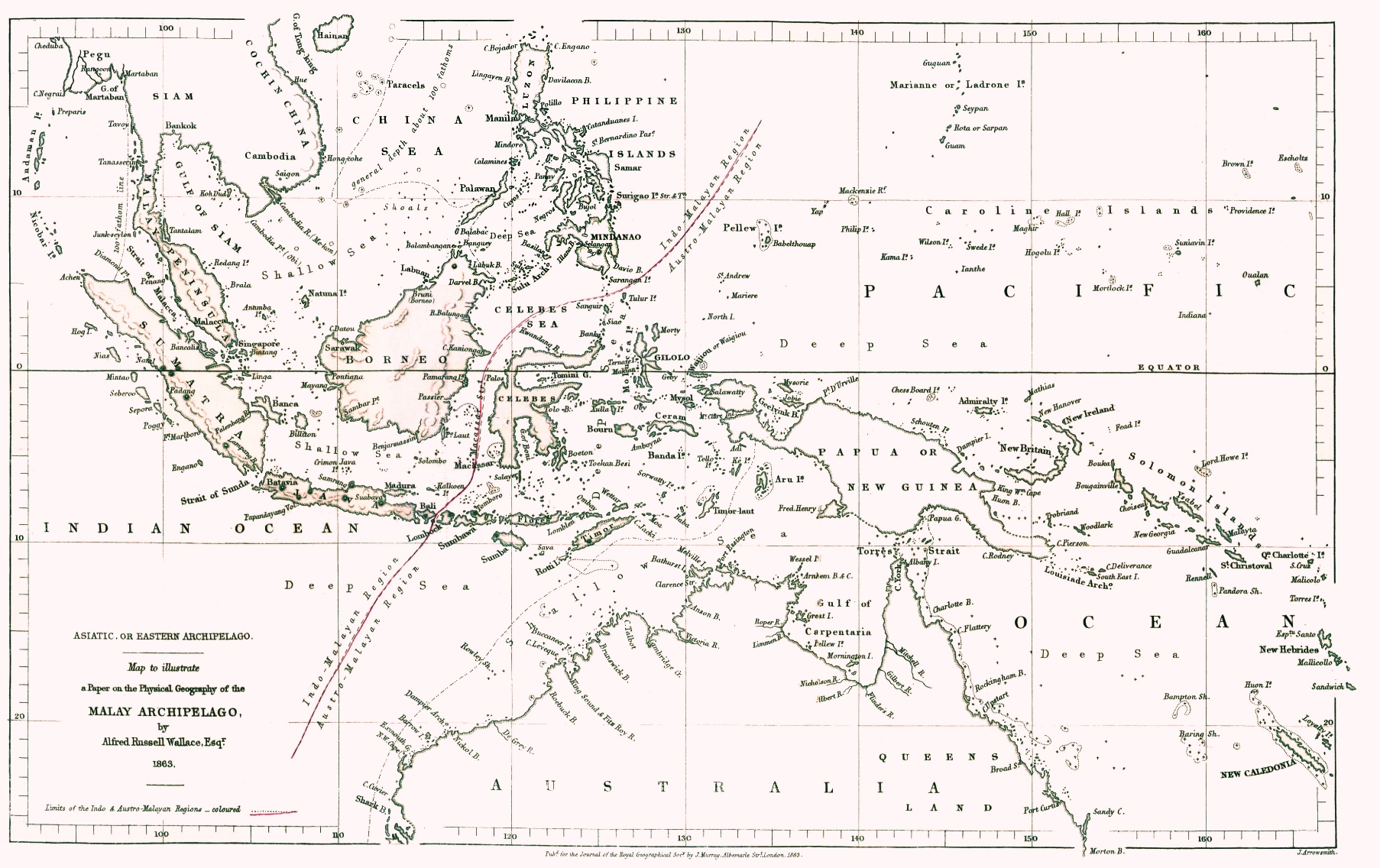Evidence from biogeography
Biogeography is the study of the geographic distribution of species. The cofounders of modern evolutionary science, Charles Darwin and Alfred Russel Wallace, both cited biogeographical evidence to support their theory. Wallace has been called the “father of biogeography” because of his seminal contributions to the field. His most famous biogeographical discovery concerns the distribution of animals on the Indonesia archipelago. Wallace noticed that most birds and mammals found in the northwestern islands of the archipelago closely resemble those of the nearby Asian continent, while animals in the southeastern islands resemble those of Australia.

In 1859, Wallace drew a line on a map delineating the boundary between Asian and Australian fauna in the Indonesian archipelago. Most mammal species and many bird species are found only on one side or the other. This map showing Wallace’s line was published in his 1863 essay “On the Physical Geography of the Malay Archipelago.”
Similarly, Darwin observed that island species often are similar (but not identical) to species on the nearest continent, suggesting that the island-dwellers migrated from the mainland and then diverged from the parent species over time. In his 1859 book On the Origin of Species, he cited specific examples in which this had apparently occurred, arguing that his theory of evolution provided a better explanation than the hypothesis that God created each species independently:
The most striking and important fact for us in regard to the inhabitants of islands, is their affinity to those of the nearest mainland, without being actually the same species. Numerous instances could be given of this fact. … The inhabitants of the Cape de Verde Islands are related to those of Africa, like those of the Galapagos to America. I believe this grand fact can receive no sort of explanation on the ordinary view of independent creation; whereas on the view here maintained, it is obvious that the Galapagos Islands would be likely to receive colonists, whether by occasional means of transport or by formerly continuous land, from America; and the Cape de Verde Islands from Africa; and that such colonists would be liable to modification;—the principle of inheritance still betraying their original birthplace.Charles Darwin, On the Origin of Species By Means of Natural Selection, or the Preservation of Favoured Races in the Struggle for Life (London: Murray, 1859), 398-399. Available online here.
Over the past century and a half since these early discoveries, biogeographical evidence has continued to provide helpful insights into the effects of natural selection, genetic drift, and gene flow in wild animal and plant populations.For more examples and further discussion of this type of evidence, see Donald R. Prothero, The Story of Evolution in 25 Discoveries (New York: Columbia University Press, 2020), Chapter 6.
Although biogeography has not been a prominent focus in many recent controversies about evolution, at least two objections have been raised against this line of evidence. First, biogeographical facts of the sort Darwin and Wallace described are instances of microevolution rather than macroevolution. As mentioned previously, some Christians believe that God supernaturally created a few original kinds of organisms (perhaps approximating taxonomic levels of “orders” or “families”) then ordained evolutionary mechanisms to diversify those original kinds into the many species we see today. Most of the biogeographical evidence is compatible with that view, so biogeography doesn’t necessarily support universal common descent.
Second, critics of mainstream evolutionary theory (and some evolutionary biologists themselves) have noted a few examples of biogeographical evidence that seem hard to reconcile with prevailing models of evolutionary history. One such example involves the distribution of primate species on the continents of Africa and South America. Geological evidence suggests that these two continents separated 180 million years ago; but genetic evidence and fossil evidence has led biologists to conclude that “new world” (American) monkeys diverged from “old world” (African and Asian) monkeys less than 30 million years ago, when the Atlantic Ocean already was too vast for monkeys to cross. It seems implausible that monkeys found a way to travel between the two continents; but if they didn’t, then evolutionary models would predict greater dissimilarities between old world and new world monkeys. Thus, biogeography seems to contradict the standard evolutionary interpretation of several lines of evidence in this case and in other similar cases.For further discussion of this example and several similar cases, see this article by paleontologist Gunter Bechly. In other words, not all of the biogeographical evidence fits neatly within the framework of mainstream evolutionary theory.